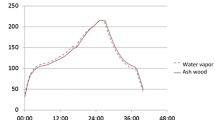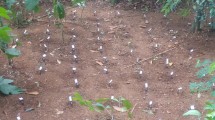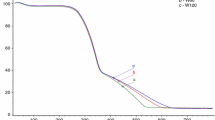Abstract
Termite resistance of thermally-treated ash (Fraxinus excelsior L) and European beech (Fagus sylvatica L) against subterranean termites (Reticulitermes banyulensis) was evaluated. A laboratory no-choice feeding test following the standard EN 177 was performed to assess the efficacy of this thermo-modification against subterranean termites in the Mediterranean area. After 8 weeks period of exposure, results showed that durability against termites was slightly improved for thermally-treated beech wood, which was classified as moderately durable. However, in case of thermally-treated ash wood, samples were highly biodegraded by termites, revealing no increase in their durability and being classified as non durable.
Similar content being viewed by others
References
Doi S, Kurimoto Y, Ohmura W, Ohara S, Aoyama M, Yoshimura T (1999) Effects of heat treatments of wood on the feeding behaviour of two subterranean termites. Holzforsch 53(3):225–229
Hill CAS (2006) Wood modification: chemical, thermal and other processes. John Wiley & Sons, Ltd, Chichester, ISBN:9780470021729
Mburu F, Dumarcay S, Huber F, Pétrissans M, Gérardin P (2007) Evaluation of thermally modified Grevillea robusta heartwood as an alternative to shortage of wood resource in Kenya: characterisation of physicochemical properties and improvement of bio-resistance. Bioresour Technol 98(18):3478–3486
Militz H (2002) Heat treatment technologies in Europe: scientific background and technological state-of-art. In: 33rd annual meeting, The international research group on wood preservation, Cardiff
Nunes L, Nobre T, Rapp AO (2004) Thermally modified wood in choice tests with subterranean termites. COST E37, Reinbeck
Shi JL, Kocaefe D, Amburgey T, Zhang JL (2007) A comparative study on brown-rot fungus decay and subterranean termite resistance of thermally-modified and ACQ-C-treated wood. Holz Roh- Werkst 65:353–358
Surini T, Charrier F, Malvestio J, Charrier B, Moubarik A, Castéra P, Grelier S (2012) Physical properties and termite durability of maritime pine Pinus pinaster Ait., heat-treated under vacuum pressure. Wood Sci Technol 46:487–501
Unsal O, Kartal SN, Candan Z, Arango RA, Clausen CA, Green F (2009) Decay and termite resistance, water absorption and swelling of thermally compressed wood panels. Int Biodeterior Biodegrad 63:548–552
Author information
Authors and Affiliations
Corresponding author
Rights and permissions
About this article
Cite this article
Oliver-Villanueva, JV., Gascón-Garrido, P. & Ibiza-Palacios, M.S. Evaluation of thermally-treated wood of beech (Fagus sylvatica L.) and ash (Fraxinus excelsior L.) against Mediterranean termites (Reticulitermes spp.). Eur. J. Wood Prod. 71, 391–393 (2013). https://doi.org/10.1007/s00107-013-0687-2
Received:
Published:
Issue Date:
DOI: https://doi.org/10.1007/s00107-013-0687-2




